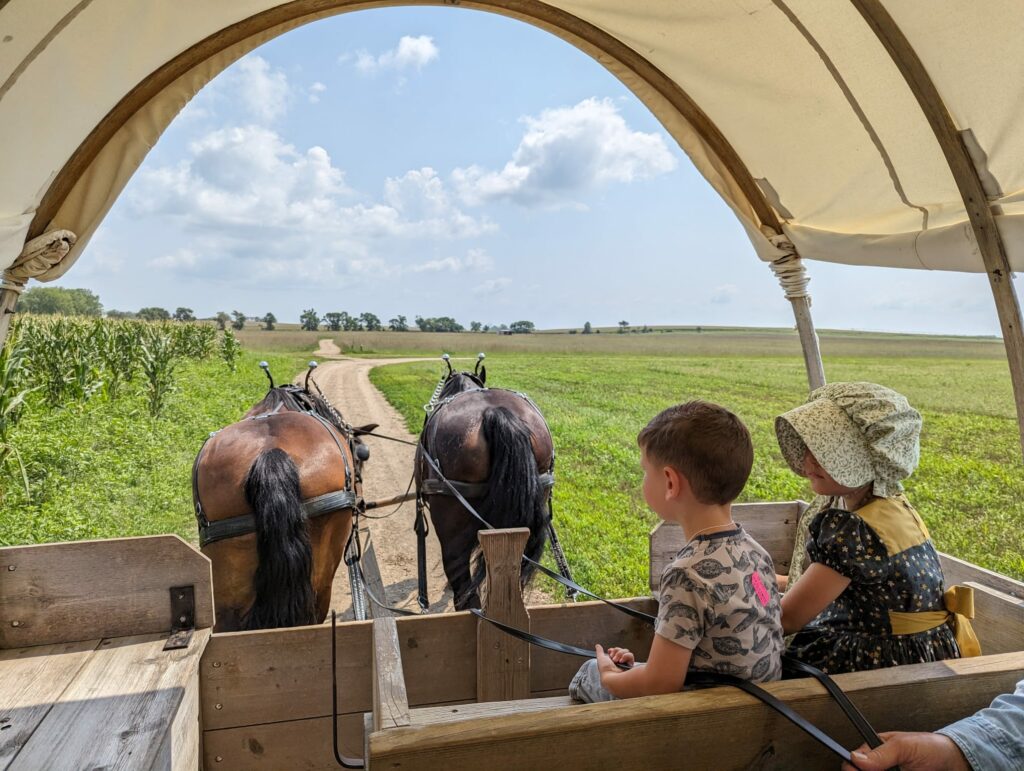Historical Essays, Literature, Travel Journalism
On the road with Laura Ingalls Wilder
Telling people that your family just visited De Smet, South Dakota, generally produces quizzical looks. Tell them, on the other hand, that you spent a day in the “Little Town on the Prairie,” and you’ll get instant recognition. That, after all, is the title of the seventh of Laura Ingalls Wilder’s nine books in the Little House series—a fact that De Smet, a tiny town of just over 1,000 people, takes full advantage of. Signs downtown, where a few stores from Wilder’s day are still in business, welcome visitors to “De Smet: Little Town on the Prairie.” Thousands of fans show up each year.
A mile southeast of De Smet is Charles “Pa” Ingalls’ original homestead, where you can still see the five cottonwood trees he planted on the first acre of the Ingalls claim—one for his wife Caroline, and one for each of his four daughters, Mary, Laura, Carrie, and Grace. The Ingalls Homestead has been set up for children. It was a hot day, but my kids got to make corncob dolls, braid rugs, and take a lesson from an old-time schoolmarm in ancient schoolhouse. We also took a covered wagon ride across the prairie, driven by a retired farmer who has lived in the area his entire life and told us that there is one old woman in town who still remembers the Ingalls family.
He let the kids drive the horses. “Just like in Laura’s day,” he said. “No,” said six-year-old Charlotte. “Laura’s wagon had oxen.” He chuckled. “How did you know?” Charlotte looked confused. “It was in the books!”
The covered wagon bumped across the hot prairie grasses to the schoolhouse, and then to the white frame Lutheran Church, which was built in 1905 about ten miles north and east of De Smet and later moved to the Ingalls claim for preservation. Children of the original attendees sometimes show up to see it; there was a wedding here last year. As kids clambered around the pews, the old famer asked us for a moment of quiet so he could share a hymn with us. He sang “The Church in the Wildwood,” written by Dr. William S. Pitts in 1857 following a coach ride stop in Bradford, Iowa, about a church in a nearby valley:
There’s a church in the valley by the wildwood,
No lovelier spot in the dale;
No place is so dear to my childhood
As the little brown church in the vale.
Come to the church in the wildwood,
Oh, come to the church in the vale;
No spot is so dear to my childhood
As the little brown church in the vale.
Oh, come to the church in the wildwood,
To the trees where the wild flowers bloom;
Where the parting hymn will be chanted,
We will weep by the side of the tomb.
The Ingalls Homestead also includes an original 1800s shanty as well as a dugout, which adds a bit of sobering reality to the warm familial glow of Wilder’s Little House books. To a young girl, the sod house on Plum Creek might have been quite exciting—the cow could graze on the roof! Stepping inside, however, one realizes anew that Pa moved a family of five into a literal dirt hole in the ground on the side of a creek, with a floor of packed soil and a roof that would drip for days after rain. The insects, of course, also sought shelter. As a boy, the idea seemed like a great adventure. As an adult with children, Ma’s response of “Oh, Charles!” when she saw said hole takes on a whole different meaning.
Most of the Ingalls sites in De Smet are tended by the Laura Ingalls Wilder Memorial Society, which was set up by several local women weeks after Wilder passed away in 1957. Buildings associated with the Ingalls family were marked by plaques, and about a decade later, the Surveyor’s House featured in By the Shores of Silver Lake was purchased and restored; the original schoolhouse attended by Laura and Carrie (in which Laura famously rocked her desk back and forth to defy the schoolteacher, her future sister-in-law Eliza Jane Wilder) was also moved to the property. It had been used as a private residence, and when the plaster walls were removed, pieces of the original chalkboards, with century-old children’s drawings, still clung to the walls. You can see them there still.
In 1972, the Society purchased the house Pa Ingalls had built for his family in town. Many of the Ingalls’ original possessions were lost. After Pa passed away in 1902, Ma and Mary rented out sections of the house to help make ends meet, storing many of their belongings in a room upstairs. Ma died in 1924, and Mary in 1928. By that time, Carrie lived in Keystone (one of her stepsons worked on Mt. Rushmore), and Grace had married farmer Nathan Dow and lived in nearby Manchester. The house was sold, and the surviving sisters couldn’t make it back to go through the remaining possessions. Most were quite literally tossed out of an upstairs window, much to the horror of Wilder fans later on—at the time, of course, they were an unknown family. The discarded belongings, the 18-year-old tour guide told us as we explored Pa’s white frame house, likely included many photographs that are now permanently lost.
The remaining possessions of the Ingalls family have been fought over and hoarded by museums and societies across the country, all of whom want a piece of America’s most famous pioneer family. Outside De Smet is a plaque commemorating where Almanzo and Laura made a go of homesteading for the first four years before setting off for Missouri; Silver Lake was drained long ago for farmland (it never worked and remains a wetland). But there are other sites across the country that lay claim to the Ingalls legacy—Pepin, Wisconsin (the little house in the Big Woods), Independence, Kansas (the little house on the prairie), Burr Oak, Iowa (where the Ingalls worked briefly at a hotel), Walnut Grove, Minnesota (on the banks of Plum Creek), and Mansfield, Missouri, where Laura, Almanzo, and their little daughter Rose moved after the De Smet homestead failed. It is in Mansfield that Laura sat down and wrote her stories, and it is in Mansfield that most of the Ingalls’ possessions have ended up.
When I asked three-year-old Lincoln what he most wanted to see, his response was immediate: “Pa’s fiddle!” Laura inherited the fiddle at Pa’s explicit request, and it now resides in Mansfield, and so off we went—a thirteen-hour drive to the Ozarks that took the three Wilders six weeks by wagon in 1894.
There are two homes on the forty-acre property owned by the Laura Ingalls Wilder Historic Home and Museum—the white farmhouse built by Almanzo to Laura’s specifications—at 4 foot 11, she wanted low counters—and “the Rock House,” a wildly expensive English cottage built for them by their daughter Rose Wilder Lane from plans she purchased from Sears Roebuck with the money she earned as one of America’s most successful freelance journalists. (The couple lived there from 1928 to 1936, and then decamped back to their beloved farmhouse.) Inside the farmhouse is the desk where Laura sat to write the first Little House books; a large portrait of Lane; paintings by Frederic Remington; her library. It is all precisely as she left it when she passed away, and the view of rolling hills of green forest from the porch make it easy to see why the couple fell in love with Rocky Ridge Farm and the Ozark countryside.
Inside the museum is a treasure trove of Ingalls artifacts. There are handwritten letters from the whole family; heirlooms from Caroline’s Quiner family; Laura’s original sampler from Little House in the Big Woods; a name card from the infamous Nellie Oleson (actually Nellie Owens); the slates Laura and Mary used as little girls in On the Banks of Plum Creek; and finally, Pa’s fiddle. Lincoln was giddy when he saw it—the fiddle, for anyone who has read the Little House books, is so essential to the stories that it is almost another character. In the original, unedited draft of Little House on the Prairie—which Laura wrote on five-cent notepads—is one of her most beautiful passages:
The nightingale sang on and on. The cool wind moved over the prairie, and the nightingale’s song was round and clear above the grasses whispering.
At last the bird was silent. Laura and Mary had not gone to sleep, but they were very quiet. Pa and Ma sat motionless and still. The sky was like a great bowl of soft light overturned on the flat, black land.
Then Pa lifted his fiddle, settled [it] against his shoulder, and touched the strings softly across the bow. A few liquid notes fell like bright drops of water into silence, a hesitating, questioning call. A pause, and Pa began to play the nightingale’s song.
The nightingale answered him, the nightingale began to sing again. It was singing with Pa’s fiddle. When the strings were silent the bird went on singing. When the bird paused Pa called to it with his fiddle and it sang again.
The nightingale and the violin were talking to each other in the cool night under the moon.
We had supper in the City Park Square in downtown Mansfield where, old-timers told me in a series of interviews about their memories of the Wilders and what it was like “back then,” the townsfolk would gather and sell their goods. On warm summer evenings like this one, with the cicadas singing loudly in the trees spreading over the grass, people would often stay out late socializing. The town is run down now, and one fellow who used to mow Laura’s lawn told me that he is one of only four or five yet living who remember the Wilders. I spotted many familiar names near the Wilder graves in the local cemetery, just as I had in the graveyard in De Smet where the rest of the Ingalls family are buried alongside the others of their generation. It is an eerie experience to see names that are so alive in the books carved on gravestones.
It reminded me of the end of Laura’s first book, which biographer Caroline Fraser says she wrote to spend more time with her father:
“When the fiddle had stopped singing Laura called out softly, “What are days of auld lang syne, Pa?”
“They are the days of a long time ago, Laura,” Pa said. “Go to sleep, now.”
But Laura lay awake a little while, listening to Pa’s fiddle softly playing and to the lonely sound of the wind in the Big Woods. She looked at Pa sitting on the bench by the hearth, the firelight gleaming on his brown hair and beard and glistening on the honey-brown fiddle. She looked at Ma, gently rocking and knitting. She thought to herself, “This is now.”
She was glad that the cozy house, and Pa and Ma and the firelight and the music, were now. They could not be forgotten, she thought, because now is now. It can never be a long time ago.
***
For those interested: My interviews with old-timers who remembered the Wilders; my essay “What you didn’t know about the real Laura Ingalls Wilder“; and my review of a recent Wilder documentary in The American Conservative, “Laura Ingalls Wilder in the Big Woke Woods.”








